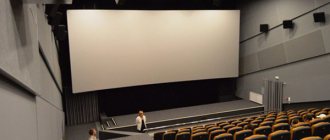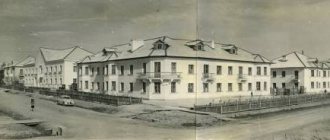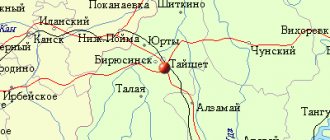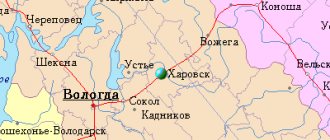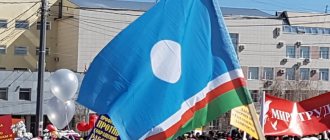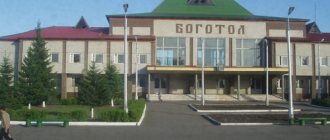Location
The administrative center of the Vilyuisky ulus of Yakutia. The city is located on the right bank of the Vilyui River (a tributary of the Lena), 592 km northwest of Yakutsk.
It really was a very small town. In Vilyuisk at the beginning of the 1870s there were four streets, on them there were forty-five houses and eleven yurts, and among the attractions were a church and a prison castle. Like a significant number of other cities in Siberia and the Far East, Vilyuisk was founded by the Cossacks. In 1634, the governor of the Yakut fort, Ivan Galkin, sent Posnik Ivanov with a dozen Cossacks to develop the Vilyui River and its left tributary Tyung - in fact, to collect yasak (that is, tribute) from local residents. The first Cossack settlement in these parts was named “Verkhnevilyuiskoye winter quarters”, later renamed Olensk (the city’s coat of arms still depicts a deer), and from 1805 it was officially called Vilyuisk.
The life of Vilyuysk residents has changed slightly since then. More than half of the inhabitants are representatives of the indigenous population, the rest are Slavs. Hunting, fishing, gathering even now, in the 21st century, remain almost the main occupation of the inhabitants. The easiest way to impress a city visitor is to invite them to go fishing in the winter, catch a plump burbot and immediately treat them to a delicacy: fresh burbot liver. Unaccustomed to the procedure of cutting up a quivering fish, it can be scary to even look at, but the taste of the delicacy turns out to be much more natural and pleasant than canned cod liver.
Industry is also present in Vilyuysk, and not only food products, including dairy products, but also concrete and wood concrete are produced; there are construction enterprises... Even gas production is underway. But nature remains in first place here - in general, in Yakutia, with its endless expanses, dependence on weather and sparse population, it is especially obvious how artificial human civilization is and how much effort and hard work must be made in order - no, not to win - to live with nature, if not in a friendly manner agreement, then in good neighborliness and harmony. By the way, the same Chernyshevsky in 1875, noting the development of agriculture in Vilyuisk, wrote: “And here the vegetables are not bad, really. But in order for them to grow, they are looked after, like pineapples in Moscow or St. Petersburg.”
Vilyuisk
(The Republic of Sakha (Yakutia))
OKATO code:
98218501
Founded:
1634
City since:
1783 City of district subordination (Vilyuisky district of the Republic of Sakha (Yakutia))
Center:
Vilyuisky district
The city was formerly called:
| Olensk | 1783 | 1821 |
| Telephone code (reference phone) | |
| 41132***** | 42-00-9 |
Deviation from Moscow time, hours:
6
Geographic latitude:
63°45′
Geographic longitude:
121°37′
Altitude above sea level, meters:
110 Sunrise and sunset times of the Sun and Moon in the city of Vilyuysk
Roots and fruits of education
In the middle of the 19th century, the level of education of the population of Vilyuysk left much to be desired. Vilyuisky police officer (the district police department, headed by the police officer, owned all executive power in the city) P. E. Clark describes a disappointing picture: “There is not a single school in the entire district, and therefore literacy among foreigners does not exist at all.” Moreover: according to Clark’s observations, the Cossacks are losing touch with their native culture, forgetting the Russian language and “living like the Yakuts.”
Little Yakut parishioners. Photo by Archpriest Sergius Klintsov
No wonder. The first educational institution in Vilyuisk, the Cossack school, did not last even seven years: in 1829 it accepted its first students, and in the spring of 1836 it closed because only a few people attended it. As a result, at the turn of the 19th and 20th centuries, when the city began to be actively built up with new buildings for a variety of needs, new educational institutions were created in Vilyuysk. By 1917, there were three schools here: a higher primary school, a parish ministerial school (from old memory it continues to be called “Cossack”) school and a missionary school for girls.
Nevertheless, the situation with literacy in Vilyuysk, as well as throughout Yakutia, continued to be deplorable - 98% of the region’s population remained illiterate on the eve of the revolution. The Soviet government is conducting an extensive program to eliminate illiteracy and is introducing basic education. In 1979, the first museum of the history of public education in the USSR was opened in Vilyuysk. Its founder, school teacher Gennady Semenovich Donskoy, is a truly outstanding person. The museum was created from scratch, out of pure enthusiasm. In a short time it is possible to find funds, find premises - not to mention collect materials. Today the museum has a large amount of unique information on the history of public education in Yakutia. Some exhibits are of particular value for the era when the museum was created. Where in the 1970s could people find out that it was the Church who brought education to indigenous peoples? But the student gave G.S. Donskoy a “Primer for the Yakuts” of 1895. And on it in rather large letters it is written: “Missionary publication. Kazan". It is worth noting that such undertakings are not uncommon in Yakutia.
Residents of the republic are very careful about the history of their family and region; there are local history museums in many localities.
In December 2014, with the blessing of Bishop Roman of Yakutsk and Lensk, a local history conference “Our Church: the history of Orthodoxy in the uluses of Yakutia” was held at the Yakut Theological Seminary. Seventy people who were passionate about the history of their native land took part in it. To this day, educational institutions continue to open in Vilyuysk - general education and secondary special education. Today, in addition to the music and art school, the city has a Vocational Technical School and a Pedagogical College named after N. G. Chernyshevsky, where several hundred students from all over the republic study.
It is worth noting that it is teenagers and young people who often visit the Vilyuisk Church of St. Nicholas in an organized manner. “The people of Vilyuysk have a well-developed sense of beauty, so they are drawn, if not to faith, then at least to beauty,” says Hieromonk Roman (Sokolnikov), rector of the St. Nicholas Church. “But they are afraid to demonstrate spiritual interest publicly: they come either individually or in organized groups.” Teachers welcome this interest. Once a week, the priest meets with students of local schools and technical schools on the territory of the temple and conducts lessons in spiritual and moral education, including an introduction to Orthodox culture: first he takes them to the bell tower, then he has a conversation directly in the temple.
Notes
- ↑ 12
www.gks.ru/free_doc/doc_2016/bul_dr/mun_obr2016.rar Population of the Russian Federation by municipalities as of January 1, 2016 - Basharin G.P.
History of agrarian relations in Yakutia: Agrarian relations from ancient times to the 1770s. - Art-Flex, 2003. - P. 49. - Olensk // Encyclopedic Dictionary of Brockhaus and Efron: in 86 volumes (82 volumes and 4 additional). - St. Petersburg, 1890-1907.
- Kalashnikov A. A.
Yakutia: chronicle, facts, events, Part 1. - Bichik, 2000. - P. 18. - ↑ 123456789101112
[www.MojGorod.ru/r_saha/vilujsk/index.html People's encyclopedia “My City”. Vilyuisk]. Retrieved June 21, 2014. [www.webcitation.org/6QUek56qk Archived from the original on June 21, 2014]. - [demoscope.ru/weekly/ssp/rus_gub_97.php?reg=80 First General Census of the Russian Empire in 1897. Yakut region]. Retrieved October 26, 2013. [www.webcitation.org/6Ked2KMGf Archived from the original on October 26, 2013].
- [demoscope.ru/weekly/ssp/rus59_reg2.php All-Union Population Census of 1959. The size of the urban population of the RSFSR, its territorial units, urban settlements and urban areas by gender] (Russian). Demoscope Weekly. Retrieved September 25, 2013. [www.webcitation.org/6GDOghWC9 Archived from the original on April 28, 2013].
- [demoscope.ru/weekly/ssp/rus70_reg2.php All-Union Population Census of 1970 The size of the urban population of the RSFSR, its territorial units, urban settlements and urban areas by gender.] (Russian). Demoscope Weekly. Retrieved September 25, 2013. [www.webcitation.org/6GDOiMstp Archived from the original on April 28, 2013].
- [demoscope.ru/weekly/ssp/rus79_reg2.php All-Union Population Census of 1979 The size of the urban population of the RSFSR, its territorial units, urban settlements and urban areas by gender.] (Russian). Demoscope Weekly. Retrieved September 25, 2013. [www.webcitation.org/6GDOjhZ5L Archived from the original on April 28, 2013].
- [demoscope.ru/weekly/ssp/rus89_reg2.php All-Union Population Census of 1989. Urban population]. [www.webcitation.org/617x0o0Pa Archived from the original on August 22, 2011].
- [sakha.gks.ru/Lists/20101/Attachments/3/03_urban%20and%20rural%20population.xls The size of the urban and rural population of the Republic of Sakha (Yakutia)] (xls). Retrieved January 10, 2013. [www.webcitation.org/6E00BDnPV Archived from the original on January 28, 2013].
- [www.gks.ru/bgd/regl/B09_109/IssWWW.exe/Stg/d01/tabl-21-09.xls Number of permanent population of the Russian Federation by cities, urban-type settlements and districts as of January 1, 2009]. Retrieved January 2, 2014. [www.webcitation.org/6MJmu0z1u Archived from the original on January 2, 2014].
- [sakha.gks.ru/wps/wcm/connect/rosstat_ts/sakha/resources/4c22eb804e8ba4699a749f7904886701/01-05.xls All-Russian Population Census 2010. Yakutia. Tab. 5. Population by region, urban and rural settlements]. Retrieved April 5, 2016. [www.webcitation.org/6gY1ButF3 Archived from the original on April 5, 2016].
- [www.gks.ru/free_doc/doc_2012/bul_dr/mun_obr2012.rar Population of the Russian Federation by municipalities. Table 35. Estimated resident population as of January 1, 2012]. Retrieved May 31, 2014. [www.webcitation.org/6PyOWbdMc Archived from the original on May 31, 2014].
- [www.gks.ru/free_doc/doc_2013/bul_dr/mun_obr2013.rar Population of the Russian Federation by municipalities as of January 1, 2013. - M.: Federal State Statistics Service Rosstat, 2013. - 528 p. (Table 33. Population of urban districts, municipal districts, urban and rural settlements, urban settlements, rural settlements)]. Retrieved November 16, 2013. [www.webcitation.org/6LAdCWSxH Archived from the original on November 16, 2013].
- www.gks.ru/dbscripts/munst/munst98/DBInet.cgi?pl=8112027 Yakutia. Population estimate for January 1, 2009-2015
- [www.gks.ru/free_doc/doc_2015/bul_dr/mun_obr2015.rar Population of the Russian Federation by municipalities as of January 1, 2015]. Retrieved August 6, 2015. [www.webcitation.org/6aaNzOlFO Archived from the original on August 6, 2015].
- taking into account the cities of Crimea
- [www.gks.ru/free_doc/doc_2016/bul_dr/mun_obr2016.rar Population of the Russian Federation by municipalities as of January 1, 2016. Table “31. Population of cities and towns by federal districts and constituent entities of the Russian Federation as of January 1, 2016.” RAR archive (1.0 MB)]
- Pesterev V.I.
History of Yakutia in faces. - Yakutsk: Bichik, 2001. - P. 102-103. — 464 p. — ISBN 5-7696-1606-7.
Under the protection of St. Nicholas
One can talk about the few churches in Vilyui for a long time and with anguish - church life here was destroyed to smithereens during the Soviet years. At the beginning of the 20th century, there were three churches in the city: St. Nicholas and Novonikolsk cathedrals and the Innocent Cemetery Church. At the leper colony located near the city, the St. Panteleimon Church operated. Now only the St. Nicholas Church has been restored in Vilyuysk. Its history begins back in 1741, when Bishop of Irkutsk Innokenty (Nerunovich), who was traveling along the banks of the Vilyui, founded a chapel in the name of St. Nicholas in the Verkhnevilyuy winter hut. A year later the temple was consecrated. Unfortunately, less than half a century later it was destroyed by fire. In its place, a two-story church was built, which existed for a hundred years - due to the erosion of the bank by the river flow, it had to be dismantled. Instead, by 1910, the single-throne Novonikolsky Cathedral was built. Emperor Nicholas II personally donated a thousand rubles for its construction. During the Soviet years, the temple first housed a post office, and then residential premises.
Cossack family. Evdokia Danilovna Kondakova, better known to Vilyuysk residents as “Kubachikha,” worked for N.G. Chernyshevsky in Vilyuysk. Photo from the archive of Sergei Rudchenko
In 1993, the Yakut diocese was revived, and soon an Orthodox community appeared in Vilyuysk. The authorities allocated part of the club building for a house of worship. The parish existed under these conditions for two decades. Only in 2006, Bishop Zosima of Yakutsk and Lensk (+2010) consecrated the site for the construction of a new church. But the work was still far from complete.
The dean of the Vilyuisky district, Hieromonk Hermogenes (Rubtsov), lived here in 2011–2012 - on the stage of the house of culture (the house of culture itself no longer existed at that time). Having woken up, he went down from the stage and ended up in the temple. It’s very convenient, you don’t have to go far. The priest talked about living conditions with a laugh: “I have a favorite basin, a favorite kettle, a favorite bucket and ladle!” Indeed, what else does a person need to be happy?
Photo from the archives of the Yakut diocese
There were two signs hanging on the doors of the former cultural center: on the right - “St. Nicholas Orthodox Parish”, and on the left - “Air Ticket Offices”. Tickets to heaven both ways, so to speak. In 2013, the magnificent golden-domed St. Nicholas Church was finally consecrated - bright, white and yellow, in the transparent watercolor expanses of Vilyuisk landscapes with wooden buildings, it looks like a palace - a real embassy of the Kingdom of Heaven. The temple was consecrated by two bishops - Bishop Roman of Yakutia and Lensk and Bishop Paisius of Gorlitsky, hierarch of the Polish Orthodox Church. In his sermon, the distinguished guest compared the Orthodox residents of Vilyui with the Rusyns he cared for, who were torn away from Orthodoxy for a long century and a half. “But after Golgotha comes the Resurrection,” the bishop saw in the new church the Resurrection for all Orthodox Vilyuisk.
Catherine from Foggy Albion
Speaking about Vilyuisk, one cannot miss another glorious and sad page of its history - the already mentioned leper colony. It was founded in 1892 by the famous sister of mercy Kat Marsden - a bright and controversial figure. She put a lot of work into creating acceptable living conditions for leprosy patients around the world. At the same time, Miss Marsden was repeatedly accused of immorality, self-promotion, financial manipulation and even espionage. In Vilyuysk, meanwhile, the memory of her and her works has been preserved very kindly. The fact is that before the appearance of “Catherine of Foggy Albion” in these parts, hundreds of lepers lived in monstrous conditions without hope of basic medical care and human sympathy.
Sister of Mercy Kat Mardsen with a map of her trip to Siberia in the background. 1892
They were afraid of leprosy. They were so panicked that they took the sick to certain death to the most inaccessible places, where there were not even roads. “The extreme fear of this disease among the Yakuts is remarkable. No one will dare not only touch the leper, but will not even dare to come close. The leper is expelled from his family. And society condemns to removal from its midst even those who do not have leprosy, but whose parents are affected by it, or who previously lived with lepers,” writes Kat about the Vilyui lepers. The only person who visited the unfortunate people was the Vilyui priest John Vinokurov, who accompanied Miss Marsden on her trips.
In fact, she came to Russia to find an unknown medicinal plant that she was told about in Turkey - an herb that supposedly grows in Siberia and cures leprosy. She meets Bishop Dionysius (Khitrov) of Ufa, a former Yakut bishop, who directs her to Bishop Meletius of Yakutia (the future Bishop of Ryazan and Zaraisk, the saint). Arriving in Yakutia, she finds out that the miraculous herb is a legend. Seeing how unbearable the life of the sick in these parts is, Sister Kat comes up with the idea of building a leper colony - a village for lepers to live. It was planned to build separate houses with vegetable gardens, men's and women's hospitals for seriously ill patients, and so on. A program of not only treatment and care was envisaged, but also psychological support and social rehabilitation of patients: those able to work had to work in workshops and engage in agriculture - not to earn money, of course, but simply to take their minds off the disease. Miss Marsden organizes fundraising around the world, initiates congresses of doctors, and inspires sisters of mercy to travel to distant Yakutia to help the unfortunate. Her feat is highly appreciated both by those for whom she works, as well as by church hierarchs and government officials... Soon the colony was built. Lepers from all over Yakutia find shelter and medical care here. Maintenance is provided by local merchants. In the 1960s, the leper colony was abolished as the disease subsided - in 1962 there were only two patients left. Today, the Vilyuisky psychoneurological boarding school is located on the territory of the colony - it was named after Kat Marsden. Many of the founder’s ideas turned out to be applicable to the patients of this institution: occupational therapy also contributes to their rehabilitation.
Khomus without mysticism
During the Soviet period, Vilyuysk remained the second cultural center of Yakutia after the capital, Yakutsk. The first Yakut professional artists work in the Vilyui People's House (house of culture). In 1929, a cinema opened. Even earlier, in 1920, there was a local history museum. Today, one of its branches is the Khomus House, where everyone can get acquainted with this “culture-forming” linguistic musical instrument for Yakutia.
Yakut tundra. Photo by Archpriest Sergius Klintsov
By the way, khomus, also known as a harp, is another living evidence of the importance of nature for northern people. It is difficult to depict a melody in the European sense on a khomus, but with its help the listener is immersed in the world of animals and elements. The performer gives the audience the cries of seagulls, the clatter of hooves of horses and deer, the sound of the river and the wind... Those who were not familiar with such art before sometimes even get scared: how is this? - you can’t hear the music, he screams like an animal... “There’s something spiritually unhealthy here!” - a resident of the middle zone thinks - and is mistaken. There is no need to look for mysticism in khomus. Just the wind, the beast and the bird - singing. And the northern man repeats their song.
Climate
Vilyuisk is located in the very north of the temperate zone of the Northern Hemisphere. The climate is sharply continental. Winters are very cold, summers are short but quite warm.
| Climate of Vilyuysk | |||||||||||||
| Index | Jan | Feb | Mar | Apr | May | Jun | Jul | Aug | Sep | Oct | But I | Dec | Year |
| Absolute maximum, °C | 0,4 | 3,3 | 8,8 | 18,6 | 30,3 | 36,1 | 37,4 | 36,0 | 27,7 | 18,0 | 3,3 | 2,5 | 37,4 |
| Absolute minimum, °C | 60,9 | 58 | 49,3 | 40,2 | 19,8 | 5,3 | 0,8 | 3,4 | 15,4 | 39,8 | 52,7 | 57,9 | 60,9 |
| Average minimum, °C | 41,5 | 36,7 | 27,2 | 14,5 | 1,4 | 8,2 | 11,7 | 8,2 | 0,8 | 11,4 | 30,3 | 39,3 | 14,4 |
| Precipitation rate, mm | 9,2 | 7,2 | 7 | 10,4 | 19 | 33,7 | 43,3 | 38,7 | 25,9 | 19,5 | 15 | 12 | 240,5 |
| Average temperature, °C | 39 | 32,7 | 20 | 7,2 | 5,0 | 14,8 | 18,3 | 14,2 | 5,6 | 7,6 | 27 | 36,5 | 9,1 |
| Average maximum, °C | 33,9 | 27,2 | 13 | 0,9 | 10,3 | 20,8 | 24,4 | 20,2 | 10,8 | 3,8 | 23 | 31,6 | 3,6 |
Flight on the Cheburashka
Vilyuysk cannot be called a hard-to-reach place - only 600 kilometers (not so far by the standards of the largest subject of the federation, on whose territory India fits) from the capital of the republic. However, for a resident of the middle zone, and especially large cities, most of Yakutia is a hard-to-reach place. It has always been this way: it is not for nothing that we began our story with Chernyshevsky’s letter. You can get to Vilyuysk from Yakutsk by taxi - as a rule, these are old but strong UAZ “goats”. As they say, tanks are not afraid of dirt. They are not afraid of off-road conditions either - it’s not for nothing that they joke here: “We have no roads, we only have directions.” It’s just a long drive: you could be shaking for seventeen hours. It gets hot here in the summer, and you can’t open the windows - you’ll be covered in sand from head to toe. One traveler told how he decided to get some air during a July trip to Vilyuysk. As a result, he breathed in dust, and his clothes had to be washed - even those that were in a tightly tied and zipped backpack. Another option is an airplane. Small nineteen-seater airplanes with the funny popular name “Cheburashka”—Czechoslovak L-410—fly regularly from Yakutsk. They shake a little, but the Cheburashkas fly low, so during the flight you can look out the window and enjoy the views with all your heart. Vilyuisk is waiting.
The material was published in the special issue of the Foma magazine “Small Towns - Heroes of Russia.” When implementing the project, state support funds are used, allocated as a grant in accordance with the order of the President of the Russian Federation dated April 1, 2015 No. 79-rp and on the basis of a competition held by the Knowledge Society of Russia.
On the screensaver, St. Nicholas Church
Days four and five: tourist base “Billeeh”
The Vilyui River is rich in fish, and the forests are rich in game. To understand this, you need to get outside the city. We're going to spend the night at the tourist base "Billeeh" (tel.), and at the same time we'll go fishing. In addition to these activities, you can also pick buckets of blueberries and blackcurrants here. There are a lot of berries in the forest.
You agree on a time with the owner of the camp site. You are picked up from Vilyuysk by boat. The swim takes about 25 minutes. The cost of transportation to the base site is included in the cost of an overnight stay in the house - 1,500 rubles. But here you can relax peacefully, away from the city noise, alone with nature.
There are also tukulans in this area, or in other words, Yakut deserts. This is another mystery of nature - sand mounds in the middle of the taiga. Scientists suggest that the tukulans are the remnants of a vast icy desert, which was subsequently overgrown with coniferous trees and became the taiga. By the way, the largest tukulans can be found in the Vilyui River basin. It is believed that such lands belong to the arid regions of Yakutia. Only to get to them you will have to walk for five hours through the taiga... It is long and dangerous. While we were walking, we came across many traces of bears. It's better not to go alone.

